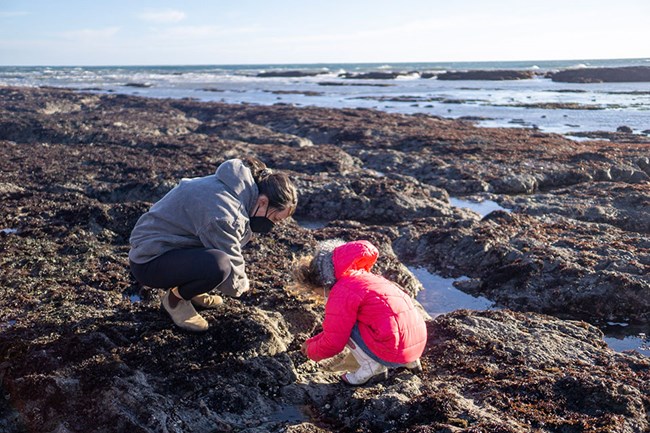
NPS / Anela Kopshever Only when waters recede at a low tide does the intertidal zone reveal its majesty to the careful explorer. This is a realm inhabited by magnificent creatures that look as if they came from another time and world. Many creatures living here resemble those who lived thousands of years ago. The intertidal zone exists halfway between land and sea on the rocky shelf where waves break and splash against rocky outcroppings. Time your exploration for the hour before and after low tide to maximize your tidepooling experience. What is the Intertidal Zone?In the intertidal zone the ocean rises and retreats twice each day. Its inhabitants are exposed alternatingly to immersion in salt water and exposure to air. The animals that survive in this sometimes wet and sometimes dry habitat are mostly invertebrates. These animals use their ability to adapt to their changing environment to escape predators. Many of the plants in the intertidal zone are algae. Observe how the different algae and kelp species change to help distinguish between tidal zones. 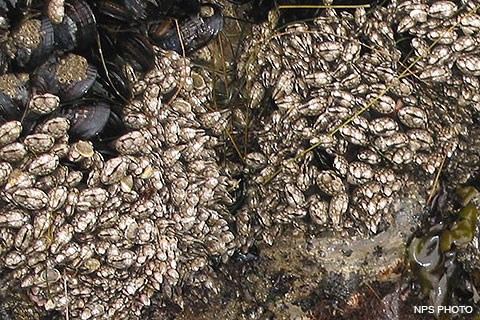
High Intertidal ZoneThe high intertidal zone is the area closest to the beach. It is covered with water only once or twice a day during high tides. Here, look for small, round, one-piece shelled mollusks called ribbed limpets. They live among acorn barnacles which are white, volcano-shaped shelled arthropods found glued to rocks. Eroded periwinkle, small-shelled snails, and black turban snails are species of gastropods (snails) found in the high intertidal zone. Periwinkle is a species found worldwide in the intertidal zone. Look for a spiral pattern in its shell similar to that which you find on its land dwelling relative, the garden snail, often seen roaming in your home garden. The black turban snail is another spiral shelled snail. Look for its black color spiraling up to an iridescent center. Take an extra look to see if the shell is indeed inhabited by a snail, or if a hermit crab has moved in. Rock weed (a type of brown algae) is easily identified by pairs of air pockets located on either side of the main vein running through the kelp. Try and spot lined shore crabs in rock crevices or by turning over rocks. 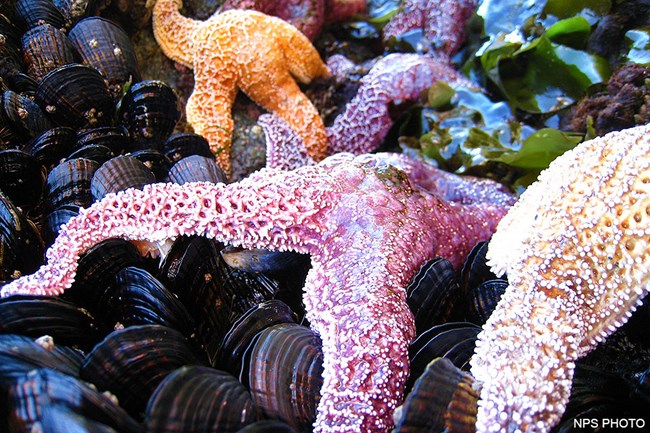
Middle Intertidal ZoneIn the middle intertidal zone, the creatures, rocks, and kelps are exposed at least once a day by tidal fluctuations. The animals of this zone cover themselves with sand and bits of shells to prevent water loss from exposure to wind and sun. Look for the ochre star. It is a purple or orange sea star which uses its tube-feet to cling tightly to the rocks. The sea star pushes water through an internal canal system to move water through its tube feet in order to hold on to the rocks, move around, and to feed. The mossy chiton, a small, flattened, oval mollusk with eight exposed plates on its back, is a treat for the diligent observer. Sea lettuce, a green alga, can be identified by its bright green color and wavy edges. It can be found attached to rocks both here in the middle intertidal zone and estuaries. Goose barnacles are also found in the intertidal zone. 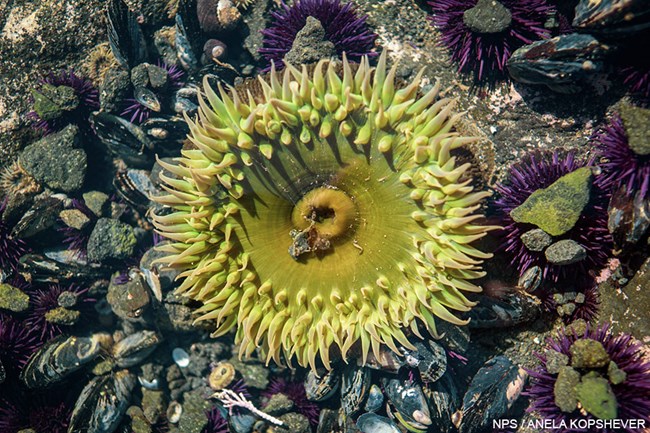
Low Intertidal ZoneThe low intertidal zone is the area exposed only during a very low tide. Look for purple sea urchins thriving amid strong wave action. These remarkable animals move along by gripping rocks with tube feet and shoving its body forward with its teeth collecting small plants along its way. One may also find the bat star, a sea star which is webbed between its arms. Giant green anemones, growing up to 17 cm wide with a vivid olive-green color and brown tentacles also thrive here. Coraline algae, an encrusting pinkish-lavender/red algae, is valued in ocean environments worldwide. Notice its hard texture due to calcification. Exploring SafelyCheck the Tide TablePlan ahead for successful tidepooling. You can find the times of the tides on the National Oceanic and Atmospheric Administration's Tides and Currents page. Tide tables are also available at visitor centers. Be sure to make the necessary time and height corrections for Point Reyes. The best time to go tidepooling is during a minus low tide. Note that not all low tides are minus tides and some low tides are not low enough for successful tidepooling. Be at the tidepool area at least an hour before low tide so that you have plenty of time to explore safely while the water is receding. Return no later than an hour after the tide has begun to rise. Always keep an open eye on the ocean. Visit our Beach Safety page for more tips and information. Dress AppropriatelyRemember that the wind is often strong at Point Reyes National Seashore, and the water is cold. Wear warm clothing and comfortable shoes that can get wet and still give good traction. Take along an extra pair of socks and shoes in case your feet do get wet. Tread LightlyTake only pictures; leave only footprints. Follow Leave No Trace's Tips for Tide Pooling:
Marine animals such as the brightly colored bat star may appear dead, while often they are merely awaiting the incoming high tide to become active. Be respectful of how these organisms live. If you turn a rock over to inspect the creatures living below it, replace the rock exactly as you found it. If, despite the advisory above against disturbing tidepool organisms, you choose to handle an organism for closer examination, put it back in the exact location and position that it was found. However, if an animal is tightly clinging to a rock, do not attempt to remove or pull it off as you may injure the organism. Marine animals have adapted precisely to the environment in which they live. Most that are returned to the wrong environment or are otherwise disturbed are unable to survive and die needlessly. Where to GoThe best and safest tidepools at Point Reyes are found at Sculptured Beach, which is located south of Coast Campground. Duxbury Reef near Agate Beach County Park in Bolinas, outside of park boundaries, is another good place to tidepool. Arrive at least an hour before low tide and leave no more than an hour after the tide begins to rise. There may be other locations where one can find tidepools in the park, but they tend to face the open ocean and are subject to larger waves. Tidepoolers have lost their lives at these other locations when they were struck by sneaker waves. 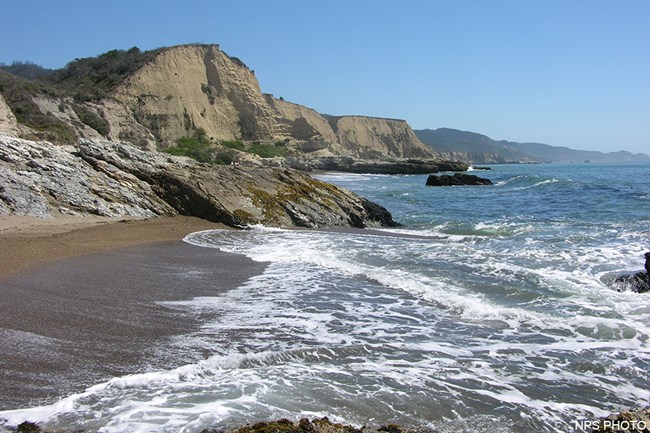
Sculptured BeachThe shortest walk to Sculptured Beach is from the Limantour Beach parking lots. Directions from Bear Valley to Limantour Beach. Allow 20 minutes for the drive, plus one hour to walk from the parking lot to the tidepools. Walk down the trail from the parking lot to the beach and turn left (south) on the beach. Sculptured Beach is approximately two miles south of Limantour Beach. Do not go past the rocks if the tide is coming in. At high tide, there is no way out! Visit our Hike to Sculptured Beach.page for descriptions of other routes. 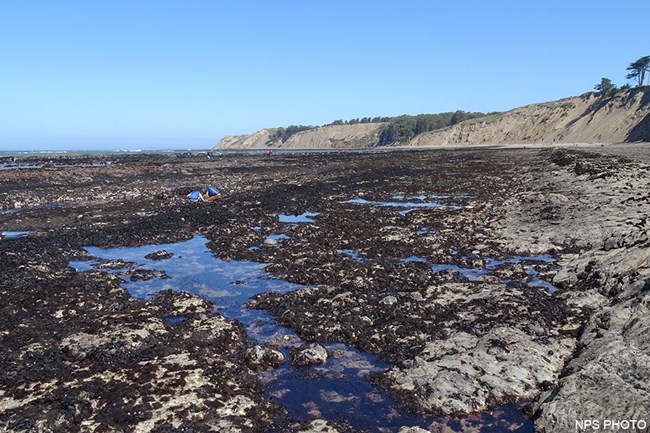
Duxbury ReefThis is the most extensive tidepool area near Point Reyes National Seashore, and has the most gentle return of the high tide. This is a good, relatively sheltered spot if you are tidepooling with children. |
Last updated: March 19, 2023
